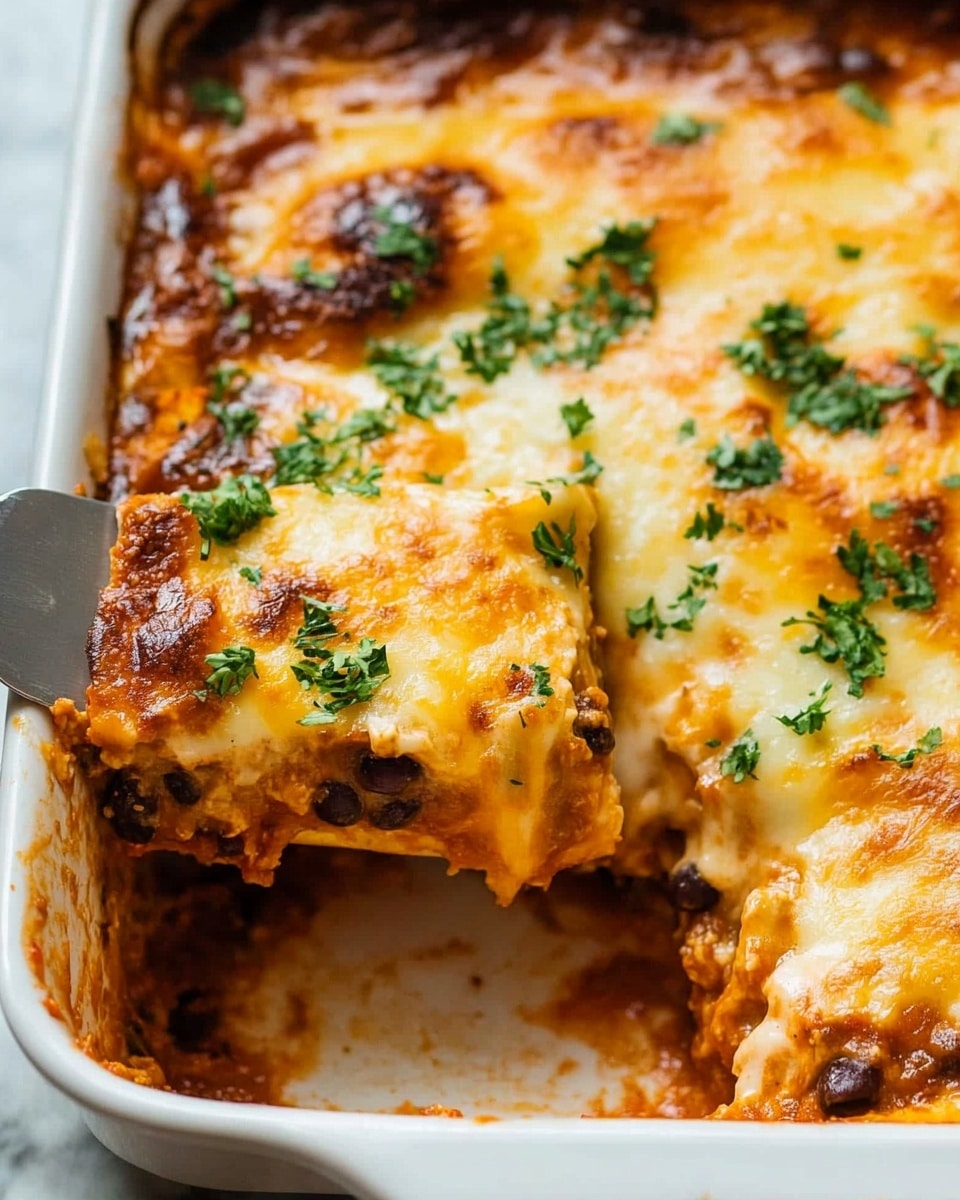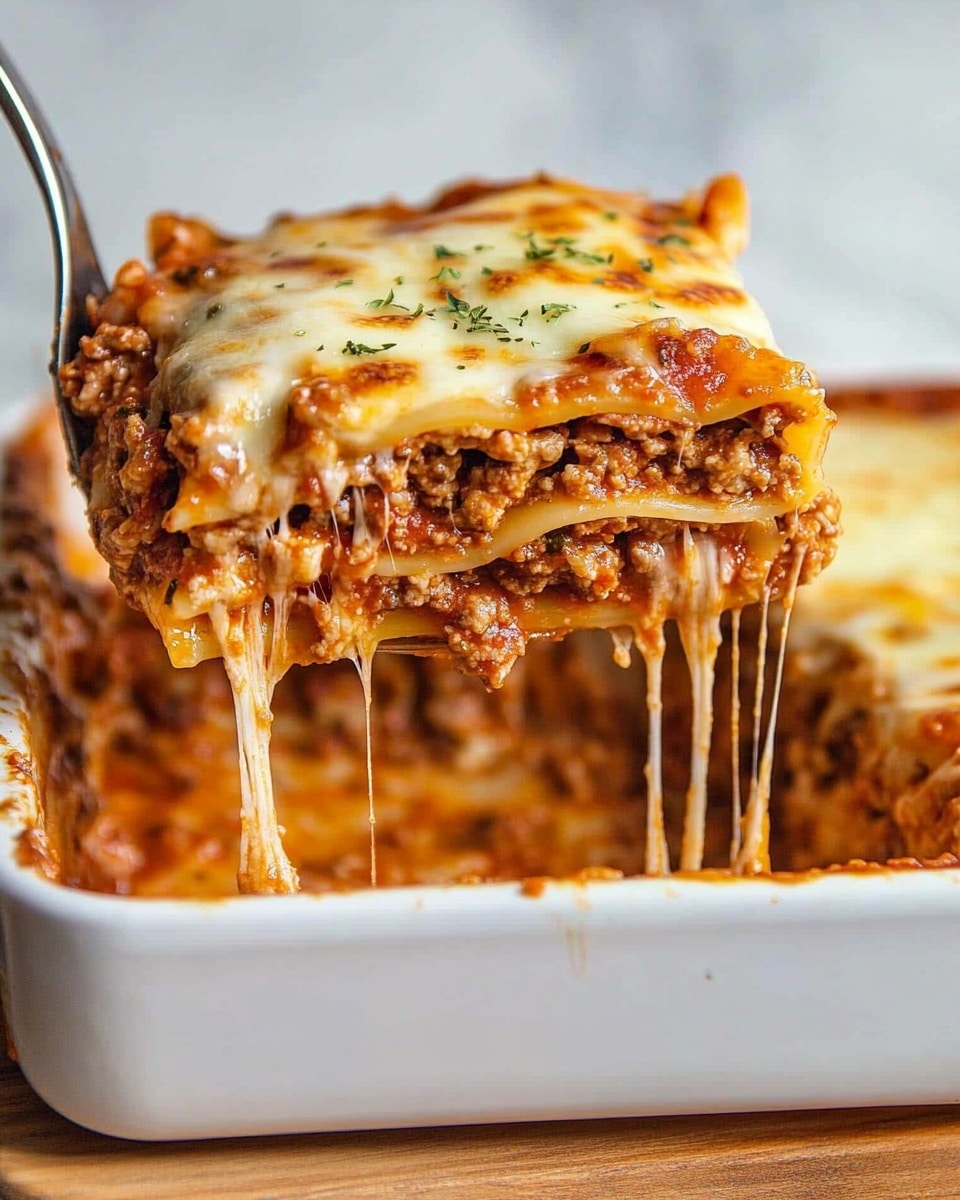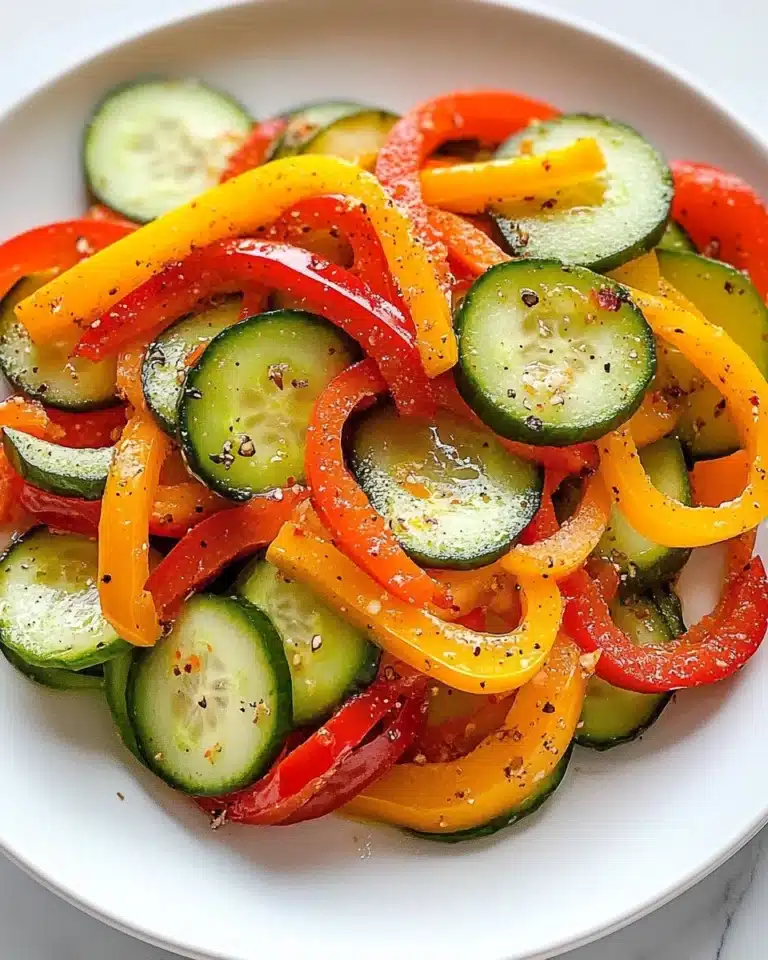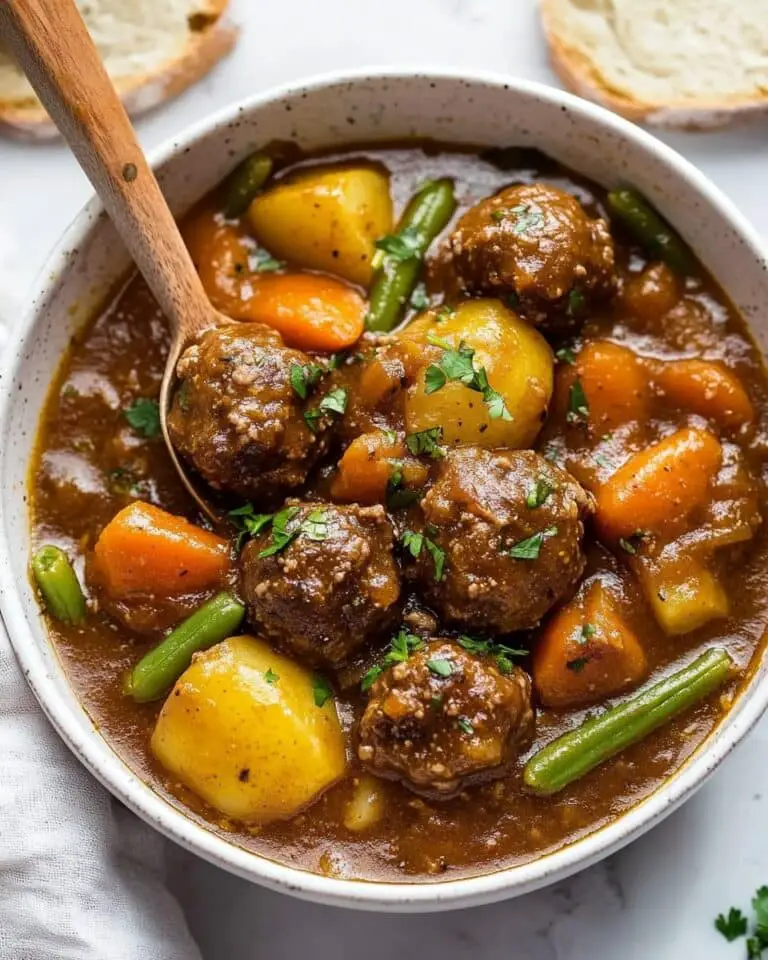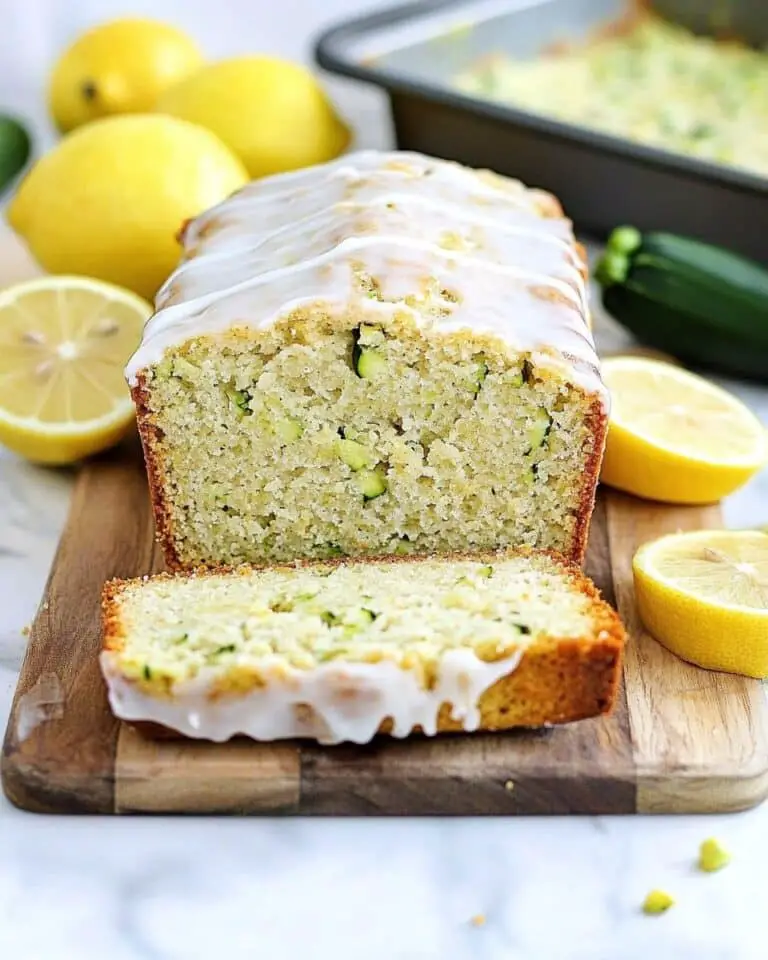If you’ve ever dreamed of making a lasagne that truly feels like a warm hug from the inside, then this is it — Simply The BEST Homemade Lasagne Recipe. I remember the first time I tried this version; the layers of rich, slow-simmered ragu mixed with luscious bechamel and ooey-gooey mozzarella just hit the spot like no other. It’s one of those dishes that works brilliantly for family dinners, special gatherings, or anytime you want to treat yourself to comfort food done right.
What makes this recipe stand out is the attention to detail in building those hearty layers, and the patience to let the sauce reduce until it’s perfectly thick and flavorful. You’ll find that once you master this Simply The BEST Homemade Lasagne Recipe, it’s going to become your go-to crowd-pleaser — and trust me, everyone will be asking for seconds (and the recipe, of course!).
Why You’ll Love This Recipe
- Authentic, Rich Flavors: The slow-simmered ragu packed with fresh herbs gives every bite a depth that’s hard to beat.
- Creamy Bechamel Balance: This smooth sauce perfectly mellows the meat and cheese, creating that classic lasagne comfort.
- Customizable Layers: You can easily adjust ingredients or add your twist while keeping the recipe foolproof.
- Make-Ahead Friendly: Prep in advance for stress-free entertaining or cozy weeknights.
Ingredients You’ll Need
Each ingredient plays a vital role in building those delicious layers. I always recommend fresh herbs and good-quality beef to elevate flavors, and fresh lasagne sheets if you can find them — they make a world of difference in texture and ease.
- Ground/Minced Beef: I suggest choosing beef with about 10-12% fat to keep it juicy without excess greasiness.
- Pancetta: Adds a savory depth; if you can’t find it, finely diced bacon works well as a substitute.
- Celery: Brings subtle crunch and freshness that balances the richness.
- Carrots: Grated carrots add natural sweetness and color to the ragu.
- White Onion: Essential for that savory base flavor—finely diced to melt perfectly into the sauce.
- Garlic: A few cloves, finely diced to infuse warmth without overpowering.
- Tomato Puree (Tomato Paste): Concentrates the tomato flavor, giving the ragu its signature richness.
- Red Wine: Don’t worry about the alcohol; it cooks off, leaving behind a wonderful depth and aroma.
- Tomato Passata (Pureed Tomatoes): Smooth and fresh-tasting, the perfect base for your sauce.
- Beef Stock: Adds extra savoriness and body to the sauce.
- Bay Leaves: Infuse subtle herbal notes that elevate the overall flavor.
- Fresh Basil & Parsley: Chop finely for freshness that brightens every bite.
- Dried Oregano: A little classic Italian seasoning to round out the herb profile.
- Sugar: Balances acidity in the tomatoes—adjust depending on your passata.
- Olive Oil: For frying and that nice, fruity undertone.
- Butter: The base of your bechamel for richness and smooth texture.
- Plain Flour: Helps thicken the bechamel to the perfect consistency.
- Milk: Use room temperature to avoid lumps in your sauce.
- Nutmeg: Just a pinch adds warmth and complexity to the bechamel.
- Parmesan Cheese: Freshly grated—trust me, it makes a huge difference.
- Fresh Lasagne Sheets: Find these in the fresh pasta aisle and they make assembling easier and neater.
- Mozzarella Cheese: Shredded for that melty, gooey top layer everyone loves.
Variations
I love that this Simply The BEST Homemade Lasagne Recipe is so adaptable. Over time, I’ve played around with adding different veggies, changing up the meat, or tweaking the cheese to fit dietary needs, and it never disappoints.
- Vegetarian Variation: Swap the beef and pancetta with a mix of diced mushrooms, lentils, and finely chopped walnuts for a hearty plant-based ragu that’s still full of umami.
- Spicier Kick: Add a pinch of chili flakes to the ragu for a gentle heat — my family loves this twist on cozy nights.
- Gluten-Free: Use gluten-free flour in the bechamel and gluten-free lasagne sheets; just be mindful the sauces reduce well to avoid sogginess.
- Creamier Bechamel: Mix in a bit of mascarpone or cream cheese for an even richer sauce, perfect for special occasions.
How to Make Simply The BEST Homemade Lasagne Recipe
Step 1: Building the Perfect Ragu
Start by heating about a tablespoon of olive oil in a large pot over medium-high heat. Toss in the ground beef, break it up with your wooden spoon, and season with salt and pepper. Fry the meat until it’s fully browned — this step seals in flavor and texture. Once browned, scoop the beef out, leaving the fat behind (unless it’s low-fat beef, then I usually keep some fat for richness).
Turn the heat to medium and add diced pancetta. Let it brown gently to release its fat, then stir in the onion, celery, and grated carrot. Cook until they soften and just start to brown — this caramelization adds natural sweetness and depth. Toss in the garlic, fry for another minute, then stir in the tomato puree to cook off the raw taste, about 2 minutes.
Deglaze the pan with red wine, scraping up all those lovely browned bits from the bottom — this step is pure flavor magic! Let the wine reduce for a few minutes before returning the beef to the pot. Now add beef stock, tomato passata, herbs (parsley, basil, oregano), bay leaves, sugar, salt, and pepper. Bring to a simmer, then reduce the heat low, cover with a heavy lid, and let it gently simmer for at least 1 hour 30 minutes. Stir occasionally to prevent sticking.
Finally, remove the lid and simmer for another 20-30 minutes until the sauce thickens beautifully. Adjust salt, pepper, and sugar to taste — this thick, flavorful ragu is your lasagne’s heartbeat.
Step 2: Whipping Up the Creamy Bechamel
In a medium pot over medium heat, melt your butter until foaming but not browned. Stir in the flour and keep stirring for about 1-2 minutes to cook away the raw flour taste while forming a roux. Now the trick: slowly pour in room-temperature milk bit by bit, whisking constantly to keep lumps at bay. Patience here really pays off.
Let this sauce gently simmer for 7-10 minutes — it should thicken enough to coat the back of a spoon, slightly thicker than double cream but still pourable. Stir in freshly grated nutmeg, parmesan, and season with salt and pepper. Taste and adjust seasoning — you want this sauce luxurious but balanced.
Step 3: Assembling Your Lasagne Layers
Preheat your oven to 350°F (180°C). In a baking dish around 8×12 inches, spread a spoonful of ragu on the bottom — this prevents pasta from sticking and it’s a sneaky way to kick-start flavor at every bite. Now here’s the layering order you’ll repeat 4 times: fresh pasta sheets, ragu, bechamel, and shredded mozzarella.
For the final, topmost layer, after the pasta sheets, dollop bechamel, then finish with mozzarella and a sprinkling of freshly grated parmesan for that irresistible golden crust. I love seeing those bubbling, browned spots on top — they add a perfect smoky charred note.
Step 4: Baking to Perfection
Bake for 30-40 minutes until the top is deeply golden and bubbling. Don’t worry if there are some ‘burnt’ bits — they add extra flavor and texture that my family actually loves! Once out, let the lasagne rest for at least 10 minutes before slicing. This waiting step is key — it helps everything set so your slices hold their shape and don’t fall apart.
Pro Tips for Making Simply The BEST Homemade Lasagne Recipe
- Reduce Your Sauces Well: Both your ragu and bechamel need to be thick enough to prevent a soggy lasagne; watch for watery layers and simmer longer if needed.
- Use Fresh Pasta Sheets: Fresh sheets cook more evenly without drying out, and they hold the layers together beautifully.
- Season Generously: Don’t be shy with salt and herbs — it really enhances the overall flavor.
- Let It Rest Before Serving: Give it at least 10 minutes outside the oven for slices that cut cleanly rather than fall apart.
How to Serve Simply The BEST Homemade Lasagne Recipe
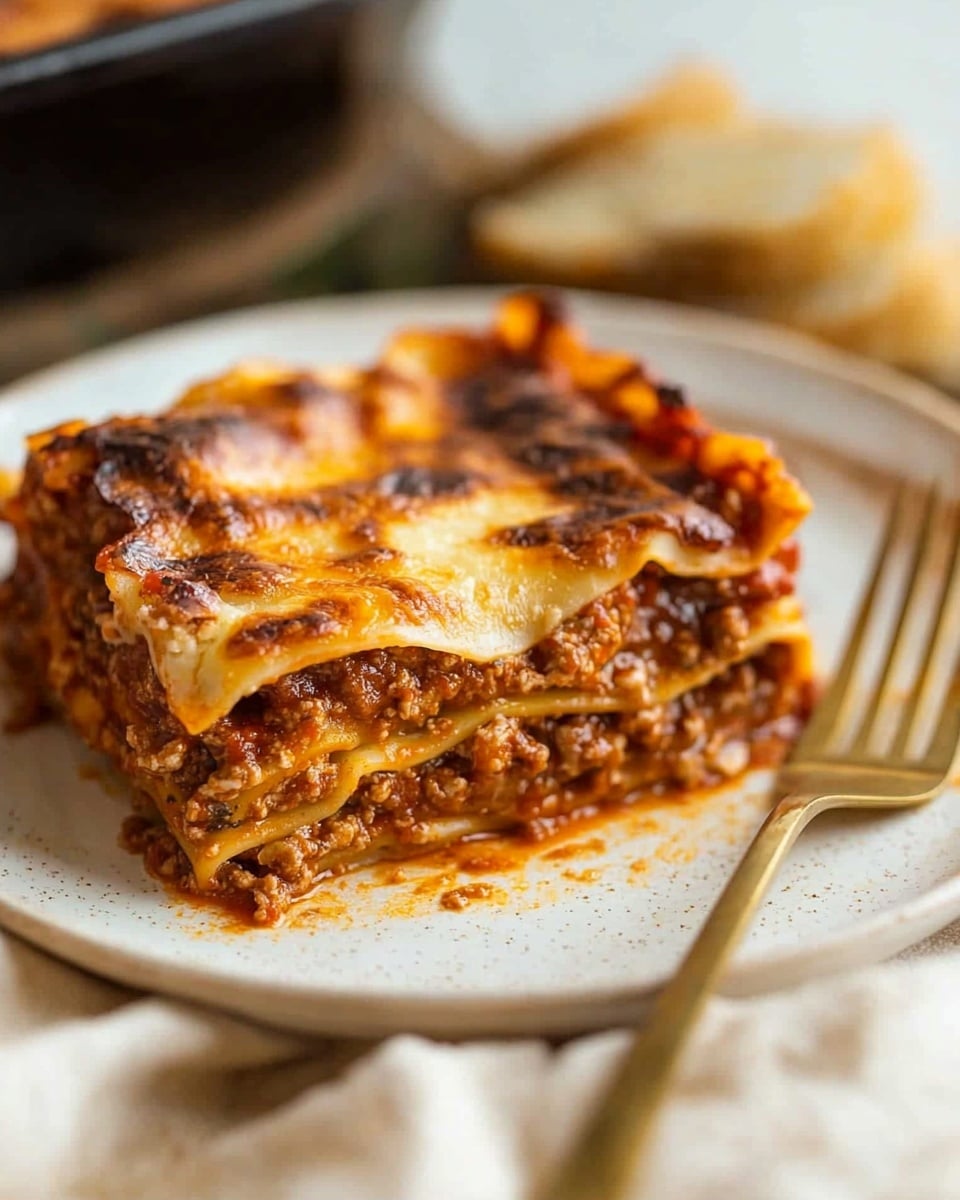
Garnishes
I’m a big fan of freshly chopped basil or flat-leaf parsley sprinkled right before serving. The freshness contrasts with the rich lasagne, adding a pop of color and a hint of brightness that makes each forkful sing.
Side Dishes
My family often pairs this lasagne with a simple green salad dressed with lemon vinaigrette — it cuts through the richness perfectly. Garlic bread on the side, warm and crusty, completes the meal with a satisfying crunch.
Creative Ways to Present
For a cozy dinner party, I sometimes serve individual portions in small ramekins or mini cast iron skillets. It makes each plate feel special and fun to eat. Also, layering extra parmesan at the top before baking creates a golden crust that looks irresistible under candlelight!
Make Ahead and Storage
Storing Leftovers
Leftover lasagne keeps beautifully in the fridge for 3-5 days. I store mine tightly covered with foil or in an airtight container to keep it moist without drying out. It often tastes even better the next day as the flavors continue to meld.
Freezing
I’ve frozen assembled lasagne before baking and also cooked leftovers. Just wrap tightly with foil and plastic wrap to avoid freezer burn. When ready, thaw overnight in the fridge and bake as instructed — it reheats wonderfully without losing its cozy charm.
Reheating
The oven is my preferred reheating method, wrapped in foil at 350°F (180°C) until warmed through, about 20-30 minutes depending on portion size. For quick meals, the microwave works — just cover and heat in intervals to avoid drying out. A splash of extra bechamel or cheese on top before reheating can refresh the creaminess.
FAQs
-
Can I use dried lasagne sheets instead of fresh?
Absolutely! Just check if the dried sheets require pre-cooking or not—some can be layered dry, others need boiling first. If using dried sheets that don’t need boiling, reduce your sauce thickness slightly, as dried pasta absorbs more liquid. This will help avoid a watery lasagne.
-
How do I keep my lasagne from being too soggy?
The key is reducing both the ragu and the bechamel sauce until they’re nicely thick. If either sauce is watery, the layers won’t set well. Also, letting the cooked lasagne rest for at least 10 minutes before slicing helps excess moisture settle, keeping your slices intact.
-
Can I make this recipe ahead of time?
Yes! You can prepare the ragu and bechamel in advance, cool them completely, then assemble the lasagne. Cover tightly and refrigerate for up to 24 hours before baking. Bringing it to room temperature before baking ensures even cooking.
-
What’s the best way to reheat leftover lasagne?
Reheating in the oven at 350°F (180°C), covered with foil, preserves texture and flavor best. Microwave works for convenience, but be careful not to overcook or it may dry out. Adding a little extra cheese or a splash of milk before reheating can help keep it moist.
Final Thoughts
There’s something truly comforting about making your own layered, cheesy, meaty lasagne from scratch, and I’m so excited for you to try this Simply The BEST Homemade Lasagne Recipe. Over the years, it’s become a family favorite that brings everyone to the table with happy smiles and full bellies. I hope you enjoy every bite as much as I do and that this recipe becomes your go-to for cozy nights and celebrations alike. Happy cooking, friend!
Print
Simply The BEST Homemade Lasagne Recipe
- Prep Time: 30 minutes
- Cook Time: 2 hours 45 minutes
- Total Time: 3 hours 15 minutes
- Yield: 8 servings
- Category: Main Course
- Method: Baking
- Cuisine: Italian
Description
This Simply The BEST Homemade Lasagne recipe features a rich, slow-simmered beef ragu layered with creamy béchamel sauce, fresh pasta sheets, and melted mozzarella and Parmesan cheese. It’s a classic Italian comfort food made from scratch, perfect for gatherings and family dinners.
Ingredients
Ragu
- 2.2lb / 1kg Ground/Minced Beef (10-12% fat recommended)
- 3.5oz / 100g Pancetta, finely diced (or bacon as substitute)
- 2 ribs Celery, finely diced
- 2 medium Carrots, grated
- 1 large White Onion, finely diced
- 3 cloves Garlic, finely diced
- 2 tbsp Tomato Puree (Tomato Paste in US)
- 1 cup / 250ml Red Wine
- 2 cups / 500ml Tomato Passata (Pureed Tomatoes in US)
- 2 cups / 500ml Beef Stock
- 2 Bay Leaves
- 1 small bunch EACH Fresh Basil and Fresh Parsley, finely diced (approx 1oz/30g each)
- 1 tsp Dried Oregano
- 1.5 tsp Sugar, or to taste
- Salt & Pepper, to taste
- Olive Oil, as needed
Béchamel Sauce
- 4 tbsp Butter (2oz/60g)
- 5 tbsp Plain Flour (2oz/60g)
- 4 cups / 1 litre Milk, at room temperature
- 1/2 small Nutmeg, finely grated
- 1 cup / 80g freshly grated Parmesan
- Salt & Pepper, to taste
Lasagne Assembly
- 12oz / 350g Fresh Lasagne Sheets (see notes for dried alternative)
- 2 cups / 200g Mozzarella, shredded
- 1/2 cup / 40g freshly grated Parmesan for topping
Instructions
- Prepare the Ragu: Heat about 1 tbsp olive oil in a large pot over medium-high heat. Add the ground beef, break it up, season with salt and pepper, and cook until fully browned. Remove beef and place it in the lasagne dish, discarding excess fat.
- Cook Pancetta and Vegetables: Reduce heat to medium, add pancetta, and cook until it browns and releases fat. Add onion, celery, and carrot; sauté until softened and lightly browned. Add garlic and cook for another minute, then stir in tomato puree and fry for a couple of minutes.
- Deglaze and Combine: Pour in red wine to deglaze the pan, reduce for a few minutes, then return the browned beef to the pan.
- Add Liquids and Herbs: Stir in beef stock, tomato passata, parsley, basil, oregano, bay leaves, sugar, salt, and pepper. Bring to a simmer, cover with a heavy lid, and cook on low heat for at least 1 hour and 30 minutes, stirring occasionally.
- Reduce Sauce: Remove lid and simmer for an additional 20-30 minutes to thicken the ragu. Adjust seasoning generously with salt and pepper to enhance flavor.
- Make Béchamel Sauce: In a separate pot, melt butter over medium heat. Add flour and stir to form a roux. Gradually whisk in milk to avoid lumps. Simmer for 7-10 minutes until sauce thickens enough to coat the back of a spoon. Stir in nutmeg, Parmesan, salt, and pepper; then remove from heat.
- Preheat Oven: Heat oven to 350°F (180°C).
- Assemble Lasagne: Spread a few spoons of ragu on the bottom of a 20x30cm (8×12 inch) baking dish to prevent sticking. Layer the lasagne as follows: pasta sheets, ragu, béchamel sauce, mozzarella. Repeat layers three more times. For the top layer, use pasta sheets, béchamel sauce, mozzarella, and sprinkle Parmesan over the top.
- Bake: Place the assembled lasagne in the oven and bake for 30-40 minutes until the surface is deep golden with some slightly browned spots for extra flavor.
- Rest and Serve: Let the lasagne sit for at least 10 minutes before slicing to help it set and maintain its shape. Serve with extra basil or parsley sprinkled on top for garnish.
Notes
- Pancetta can be substituted with finely diced bacon.
- Adjust sugar after the ragu has simmered; good quality tomatoes may not need additional sugar.
- Both ragu and béchamel must be well reduced to avoid a watery lasagne; sauces should be thick enough to coat the back of a spoon.
- Use an 8×12 inch baking dish for perfect layering; smaller, deeper dishes require more layers.
- Fresh lasagne sheets are preferred; if using dried sheets, check package instructions and adjust sauce reduction accordingly.
- Choose ground beef with 10-12% fat for optimal flavor and texture; drain excess fat if using higher fat beef.
- Use a heavy top lid when simmering ragu to regulate steam and reduce slowly.
- Lasagne can be made ahead; cool ragu and béchamel before assembling, then refrigerate or freeze before baking.
- Store leftovers refrigerated 3-5 days or frozen long-term; reheat in oven or microwave until hot throughout.
- Calories and nutritional info are calculated per serving when dividing the recipe into 8 servings.
Nutrition
- Serving Size: 1/8 of the recipe
- Calories: 610 kcal
- Sugar: 8 g
- Sodium: 620 mg
- Fat: 28 g
- Saturated Fat: 14 g
- Unsaturated Fat: 12 g
- Trans Fat: 0.5 g
- Carbohydrates: 48 g
- Fiber: 4 g
- Protein: 38 g
- Cholesterol: 105 mg

